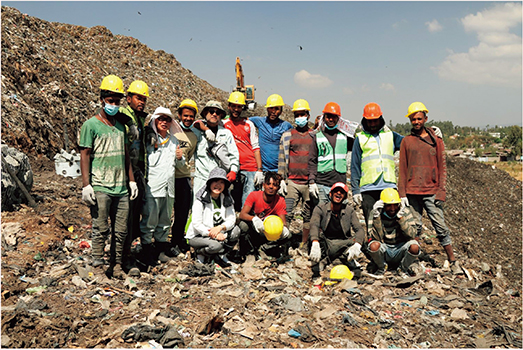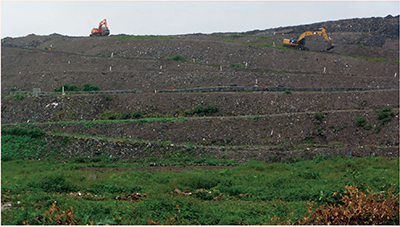MASTER TECHNIQUES from Japan to the World 2
Waste Management in Ethiopia Improved with Landfill Technology from Fukuoka
– Working with Local People –

Three Japanese experts who gave on-site technical assistance and the waste pickers who worked together with them (Third from the left (back row): Professor Emeritus Matsufuji) (Photo: UN-Habitat)

The Koshe dump site in Addis Ababa improved using the Fukuoka Method (Photo: UN-Habitat)
In Ethiopia, the amount of garbage has increased in recent years due to the rapid urban population growth and changing lifestyles, but the development of solid waste disposal facilities has not kept pace, making waste management a major issue. Notably, the Koshe dump site, Ethiopia’s largest dump site for garbage in Addis Ababa, the capital city of the country, was in urgent need of finding a solution after an accident in 2017 when the garbage that had been piled up to a height of 50 meters collapsed and more than 200 people lost their lives.
In response to this accident, in 2018, through the United Nations Human Settlements Programme (UN-Habitat), Japan provided emergency technical support to improve the Koshe dump site, by implementing the “Fukuoka Method,” a Japanese landfill technology with a proven track record in solid waste management.
The “semi-aerobic landfill type” is a landfill technology known as the “Fukuoka Method,” which is an environmentally conscious landfill technology originally designed in Japan. It was jointly developed by Fukuoka City and Fukuoka University in Japan in the 1970s, and was devised and put into practice by Professors Emeritus Dr. HANASHIMA Masataka and Dr. MATSUFUJI Yasushi at Fukuoka University. This technology facilitates the inflow of outside air via leachate collection pipes installed at the bottom of the landfill so that the decomposition of landfilled waste is accelerated by activating microorganisms in the waste layer. This technology also purifies leachate and inhibits the emission of methane gas, one of the greenhouse gases. Another feature is that it can be introduced at a low cost by using local materials such as bamboo and oil drums.
Dr. Matsufuji speaks from his own experience that to introduce the Fukuoka Method in landfills where there is neither heavy machinery nor tools available, and where there are people who make their living by picking up waste (waste pickers), just passing on the technology will not work. Therefore, Dr. Matsufuji himself visits the dump site facilities and provides technical assistance to introduce the method while gaining the cooperation of waste pickers. “Waste pickers, who are frowned upon by the public, are our partners who contribute to the separation and reduction of waste, if you look at them from another perspective. Through the cooperation of waste pickers, the introduction of the Fukuoka Method will be accelerated. At the same time, it makes the dump site safer and their work easier. As we work together and improve the dump site, they become gentler and more cooperative,” he says.
Following its success in Addis Ababa, calls for the introduction of waste management through the Fukuoka Method increased, not only from within Ethiopia but also from 21 other countries. In Ethiopia, a project was started in Bahir Dar City in 2019 and also in Hawassa City since 2021 as part of the “African Clean Cities Platform (ACCP)”Note 1 initiative.
Dr. Matsufuji receives requests for cooperation in improving landfill facilities from many countries. Regarding the future expansion of the method to other countries, he says, “There are dozens of landfill facilities in a single country, and the budget is limited. Since it is difficult for me to visit every facility myself, I would like to focus more on developing human resources who can convey the correct techniques and knowledge, hoping to widely spread the Fukuoka Method.” Currently, plans are underway under Dr. Matsufuji’s leadership to establish regional training centers that will utilize both onsite and online training in areas such as Southeast Asia, South America, and Africa. It is hoped that Japanese technology will lead to improvements in sanitary landfill facilities in these regions.
Note 1: See the glossary.
<< Previous Page Next Page >>
Main Text | Reference Statistics | Stories from the Field | Master Techniques from Japan to the World | ODA Topics
